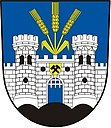Nýřany
| Nýřany | ||||
|---|---|---|---|---|
|
||||
| Basic data | ||||
| State : |
|
|||
| Region : | Plzeňský kraj | |||
| District : | Plzeň-sever | |||
| Area : | 2279 ha | |||
| Geographic location : | 49 ° 43 ' N , 13 ° 12' E | |||
| Height: | 336 m nm | |||
| Residents : | 6,975 (Jan 1, 2019) | |||
| Postal code : | 330 23-330 34 | |||
| traffic | ||||
| Street: | D 5 Plzeň - Rozvadov | |||
| Railway connection: |
Plzeň – Furth in the Nýřany – Heřmanova Huť forest |
|||
| structure | ||||
| Status: | city | |||
| Districts: | 3 | |||
| administration | ||||
| Mayor : | Jiří Davídek (as of 2007) | |||
| Address: | Benešova třída 295 330 23 Nýřany |
|||
| Municipality number: | 559300 | |||
| Website : | www.nyrany.cz | |||
Nýřany (German Nürschan , formerly Nyrschan ) is a city in the Czech Republic and belongs to the Okres Plzeň-sever .
Geographical location
The city is located in western Bohemia in the hollow of the Vejprnický potok ( Weipernitzer Bach ) in the Pilsen Hills, twelve kilometers west of the city center of Pilsen .
The route of the D 5 motorway runs south of the city, and exit 93 Nýřany lies in the south-east. There are several decommissioned coal mines in the vicinity of Nýřany.
Neighboring towns are Doubrava, Pankrác and Myslinka in the north, Tlučná in the north-east, Sulkov and Líně in the south-east, Úherce , Týnec and Hoříkovice in the south, Kotovice and Nový in the south-west, Přehýšov and Blatnice in the west and Kamenný Újezd in the north-west.
history
Nýřany was first mentioned in a document in 1272. The farming village belonged to the Chotěšov monastery until it was dissolved in 1782 and was then administered by the religious fund. After Prince Karl Alexander von Thurn und Taxis acquired the Chotěšov rule for 1,080,000 guilders in 1822, Nýřany remained in the possession of this family until the patrimonial rule was abolished and in 1848 became an independent municipality.
The discovery of an important coal deposit changed the village seriously. After the construction of the railway from Pilsen to Furth im Wald in 1861, numerous shafts were sunk around Nyrschan. Mining increased the population and a colony of miners was built next to the village.
The entrepreneur Hermann Dietrich Lindheim used the convenient location and the good quality of the coal to build a steel and sheet metal rolling mill that belonged to the Prague iron industry company . In 1890 a private railway was established to Hermannshütte in Wilkischen, on which public passenger traffic and from 1920 regular rail traffic was started. A glassworks was added later. In 1880 there were 4,258 people in Nyrshan. Emperor Franz Joseph I elevated the industrial community to a city in 1892. In 1889 there was a miners' strike in the coal mines, which ended in bloody fashion.
After the First World War , Nürschan was added to the newly created Czechoslovakia in 1919 . Due to the Munich Agreement , the city came to the German Reich in 1938 and belonged to the district of Mies , administrative district of Eger , in the Reichsgau Sudetenland until 1945 . In 1939 Nürschan had 4040 inhabitants.
In the last days of the Second World War , in April 1945, rail transports with several thousand prisoners rolled through the city in 50–60 closed and open wagons on the railway line from Pilsen to Taus . On May 5, 1945, Nürschan was occupied by soldiers of the 3rd US Army . Immediately after the end of World War II , the German population Nürschan was sold .
Demographics
| year | Residents | Remarks |
|---|---|---|
| 1837 | 245 | in 31 houses |
| 1880 | 4258 | |
| 1900 | 5602 | German and Czech residents |
| 1921 | 5822 | 1433 of them are German residents |
| 1930 | 6043 | |
| 1939 | 4040 |
| year | 1970 | 1980 | 1991 | 2001 | 2003 |
|---|---|---|---|---|---|
| Residents | 6 191 | 6 419 | 7 158 | 6 913 | 6,942 |
Local division
The town of Nýřany consists of the districts Doubrava ( Dobraken ), Kamenný Újezd ( Steinaujezd ) and Nýřany ( Nürschan ).
Attractions
- Church of St. Prokop, the neo-Gothic building by the architect Rudolf Vomáčka was consecrated in 1904
- Town hall, neo-renaissance building from 1885
- Chapel of St. Wenceslas on the old village square, built in the 15th century
- Memorial to the miners who were shot down, at the Marta shaft
sons and daughters of the town
- Waldemar Gibisch (1894–1948), conductor and composer
- Anna Letenská (1904–1942), actress and resistance fighter
Web links
Individual evidence
- ↑ Český statistický úřad - The population of the Czech municipalities as of January 1, 2019 (PDF; 7.4 MiB)
- ↑ Johann Gottfried Sommer : The Kingdom of Bohemia . Volume 6: Pilsner Kreis , Prague 1838, p. 146, paragraph 34.
- ^ Meyer's Large Conversational Lexicon . 6th edition, Volume 14, Leipzig and Vienna 1908, p. 846 .
- ^ Sudetenland Genealogy Network
- ^ A b Michael Rademacher: German administrative history from the unification of the empire in 1871 to reunification in 1990. Mies district (Czech Stríbro). (Online material for the dissertation, Osnabrück 2006).
- ↑ Czech population statistics




